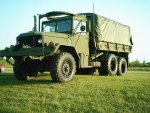emr
New member
- 3,209
- 25
- 0
- Location
- landing , new jersey
91W350 U have experience, it really is simple snow and mud need that slice thru, or U just lose all your power with the snow plow affect pushing alot of mud and snow, now like said above,"wouldn't they just sink in way down ? well sure in some thing as deep in your mind U are saying I think, any tire would sink, but it really is simple, wide and big is for sand and rocks, watch the rock climbers and then the swamp runners, it says it all, now the driver and vehicle have alot to say here, but the basic facts are true since the beginning of tire design and are true today, many people say . : My big wide tires were the best there is in mud and snow, well to them this is true , but there opinion is in a very narrow area of experience, because it is not true, only for them at that time, can U see what i am sayin, no disrespect intended, but facts are facts. Oh and NDTCCs are awesome in all conditions as long as they are driven and aired correctly, so those that say they heard or believe they are terrible, again have limited experience, they have had the longest run in service than any tire ever, and that is for a reason, not by accident , not because the guys sending these trucks out are stupid, actually they are smart and were correct in the tire they chose, heavy duty and awesome in a wide variety of climates and terrains, and in the past deserts were not the mainstay of fighting either, but when ndts were sent to the desert for one example, An M 38 had 700 tires for sand service there were fitted with 750s , even in ww 2 they new these facts, many many tests have proved and re proved this for the history of these trucks,



